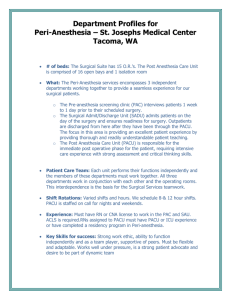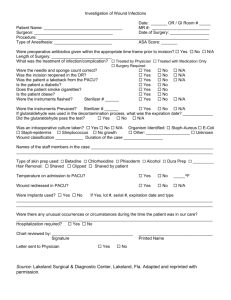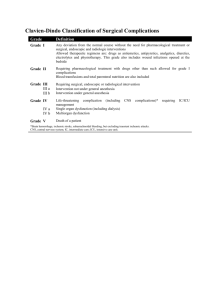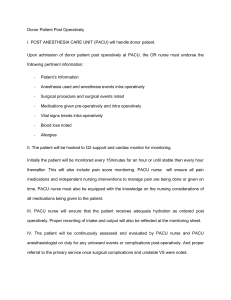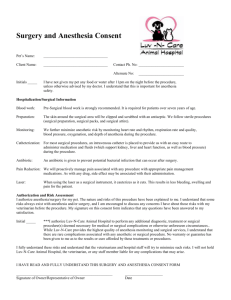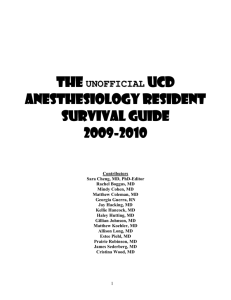Management and treatment of the PERI
advertisement
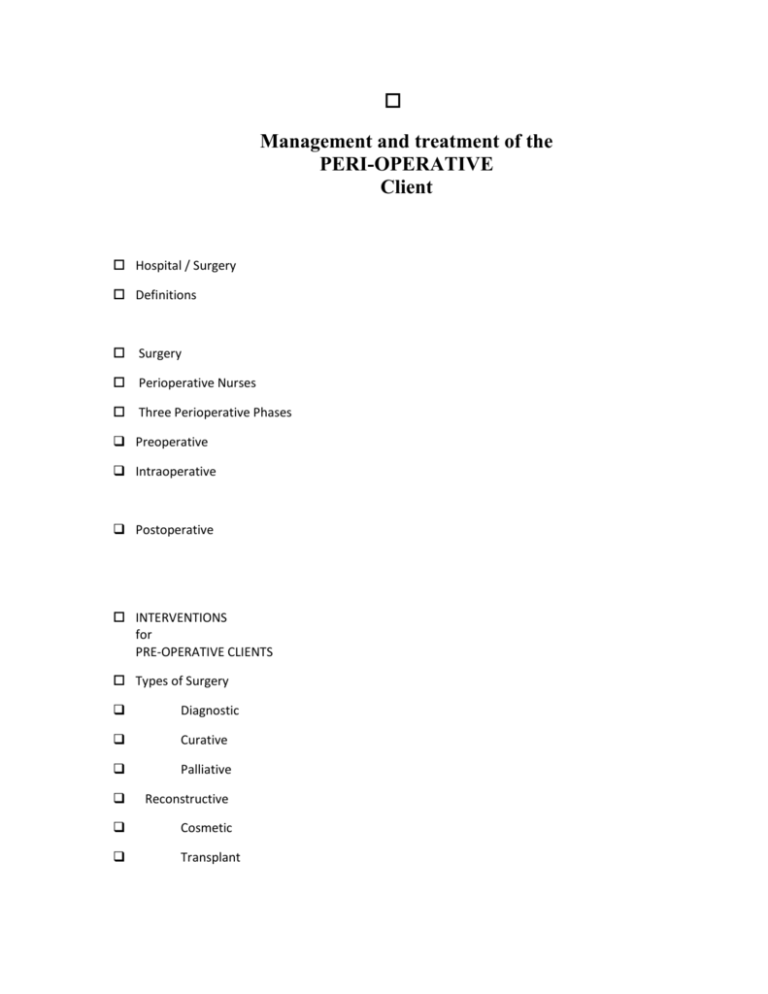
Management and treatment of the PERI-OPERATIVE Client Hospital / Surgery Definitions Surgery Perioperative Nurses Three Perioperative Phases Preoperative Intraoperative Postoperative INTERVENTIONS for PRE-OPERATIVE CLIENTS Types of Surgery Diagnostic Curative Palliative Reconstructive Cosmetic Transplant Types of Surgery Emergent Urgent Elective Inpatient Outpatient Types of Surgical Facilities Hospitals (Large & Small) Ambulatory Care Free-standing Surgical Centers Doctors’ Offices Surgeon Responsibilities Primary Physician Surgical Intervention Setting Diagnostic Tests Consent Outcomes and Risk Major role of the Surgeon Preoperative Nursing Care Pre-op Assessment Health History Pre-Op Assessment Psychosocial Aspects Coping ability Anxiety level Support system Common fears Physiological Aspects Purpose Lab data Radiographic assessment Other diagnostic assessments Factors which influence risk Nursing Management Surgical Consent Forms Purpose Components Common Orders Client’s routine medications Specific preparations ordered by Physician NPO status Preoperative medication Pre-Operative Phase ALL OTHER PREPARATIONS MUST BE COMPLETED BEFORE GIVING PRE-OP MEDS! Pre-Op Medications 1. Routine meds usually held 2. Routine meds usually given 3. Pre-op meds a. Common meds Narcotics Sedatives - Hypnotic Anti- cholinergics Amnesics Pre-Op - Checklist Nurse completes check - list for inpatient or outpatient surgery Nurse signs off to Anesthesia/Circulator Nurse places documentation on chart and includes INTERVENTIONS for INTRA-OPERATIVE PATIENTS Intra-operative Holding Area Operating Room (OR) Nurses’ Roles Surgical Team Members Surgeon Surgical Assistant Anesthesiologist Certified Registered Nurse Anesthetist (CRNA) Circulating Nurse Scrub Nurse Specialty Team Types of Anesthesia General Given inhalation and intravenous CNS depressed: Risk for Cardiac and respiratory Induction Maintenance Emergence Phases Types of Anesthesia Monitored Controlled Anesthesia (MAC) Regional Conscious Sedation Anesthesia Medication Unconsciousness Analgesia Reflex loss Muscle relaxation amnesia Care of Client (Elderly) INTERVENTIONS for POST-OPERATIVE PATIENTS Post-operative Transfer from OR to PACU PACU Report to PACU nurse Assessment Prevention/Complications Cardiovascular Hemorrhage, Hypovolemic Shock Deep Venous Thrombosis (DVT) Pulmonary Embolism Complications Respiratory Atelectasis Prevention Aspiration Complications Elimination Problems effects Anesthesia, lack of activity, pain meds Urine Elimination Bowel Elimination Discharge from PACU Based on: Respirations Energy Alertness Circulation Temperature Discharge from PACU to Ambulatory Surgical Unit Discharge from PACU to General Surgical Unit Complications General Post-Op AMBULATION: the single most significant measure to prevent complications Stress Related to Surgery General Adaptation Syndrome Sympathetic Effects 1. Manifestations Continue (GAS) bronchial dilation water and sodium retention After 24 hours, post-op diuresis ADH fluid retention Electrolyte imbalances Effects of Cortisol protein catabolism immune response platelets Discharge Home care preparation Health teaching Psychosocial preparation Health care resources Wound Healing Healing Wound Drainage Wound Disruptions Sutures Acute Pain Types of Drains Penrose T-Tube Jackson-Pratt Hemo-vac Recording Communication Healing Primary Intention Secondary Intention Tertiary Intention Wound Drainage Serous Sanguineous Purulent Wound Disruption Dehiscence Evisceration Types of Skin Closures a. Sutures Interrupted Continuous Sutures Staples Steri-strips Retention Sutures Retention Bridge Acute Pain Adequate Pain Control Client participation in pain control Promotion of Recovery Discharge Instructions Follow-up plans Home Care Wound Care Prescriptions Contact Person Follow-up Appointment Questions ?????
